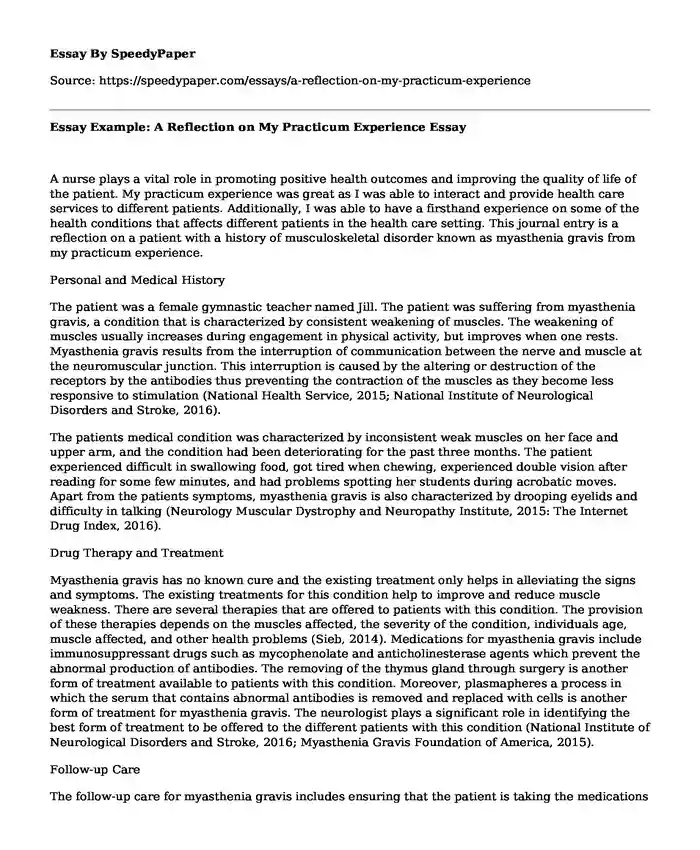
| Type of paper: | Essay |
| Categories: | Nursing Internship |
| Pages: | 3 |
| Wordcount: | 711 words |
A nurse plays a vital role in promoting positive health outcomes and improving the quality of life of the patient. My practicum experience was great as I was able to interact and provide health care services to different patients. Additionally, I was able to have a firsthand experience on some of the health conditions that affects different patients in the health care setting. This journal entry is a reflection on a patient with a history of musculoskeletal disorder known as myasthenia gravis from my practicum experience.
Personal and Medical History
The patient was a female gymnastic teacher named Jill. The patient was suffering from myasthenia gravis, a condition that is characterized by consistent weakening of muscles. The weakening of muscles usually increases during engagement in physical activity, but improves when one rests. Myasthenia gravis results from the interruption of communication between the nerve and muscle at the neuromuscular junction. This interruption is caused by the altering or destruction of the receptors by the antibodies thus preventing the contraction of the muscles as they become less responsive to stimulation (National Health Service, 2015; National Institute of Neurological Disorders and Stroke, 2016).
The patients medical condition was characterized by inconsistent weak muscles on her face and upper arm, and the condition had been deteriorating for the past three months. The patient experienced difficult in swallowing food, got tired when chewing, experienced double vision after reading for some few minutes, and had problems spotting her students during acrobatic moves. Apart from the patients symptoms, myasthenia gravis is also characterized by drooping eyelids and difficulty in talking (Neurology Muscular Dystrophy and Neuropathy Institute, 2015: The Internet Drug Index, 2016).
Drug Therapy and Treatment
Myasthenia gravis has no known cure and the existing treatment only helps in alleviating the signs and symptoms. The existing treatments for this condition help to improve and reduce muscle weakness. There are several therapies that are offered to patients with this condition. The provision of these therapies depends on the muscles affected, the severity of the condition, individuals age, muscle affected, and other health problems (Sieb, 2014). Medications for myasthenia gravis include immunosuppressant drugs such as mycophenolate and anticholinesterase agents which prevent the abnormal production of antibodies. The removing of the thymus gland through surgery is another form of treatment available to patients with this condition. Moreover, plasmapheres a process in which the serum that contains abnormal antibodies is removed and replaced with cells is another form of treatment for myasthenia gravis. The neurologist plays a significant role in identifying the best form of treatment to be offered to the different patients with this condition (National Institute of Neurological Disorders and Stroke, 2016; Myasthenia Gravis Foundation of America, 2015).
Follow-up Care
The follow-up care for myasthenia gravis includes ensuring that the patient is taking the medications as prescribed by the doctor so as to maintain high levels of strength. The patient should also be placed on proper nutrition which will promote muscle strength and optimal weight. Additionally, the patient should be encouraged to avoid emotional extremes and use stress-reduction techniques. Moreover, the patient should be encouraged to take rest in between the exercising periods (National Institute of Neurological Disorders and Stroke, 2016).
Conclusion
My interactions and observation of Jill during my practicum taught me a lot about myasthenia gravis. I gained a deep insight on the cause, symptoms, treatment, and follow-up care of myasthenia gravis. I also understood why different patients receive different therapies for myasthenia gravis. The knowledge gained will be instrumental in helping me provide future care to patients suffering from this condition.
References
Mayo Clinic. (2016). Myasthenia gravis: Symptoms and causes. Retrieved from http://www.mayoclinic.org/diseases-conditions/myasthenia-gravis/symptoms-causes/dxc-20200262
National Institute of Neurological Disorders and Stroke. (2015). Treatment for MG. retrieved from http://www.myasthenia.org/WhatisMG/TreatmentforMG.aspx
National Health Service. (2015). Myasthenia gravis: Symptoms. Retrieved from http://www.nhs.uk/Conditions/Myasthenia-gravis/Pages/Symptoms.aspx
National Institute of Neurological Disorders and Stroke. (2016). Myasthenia gravis fact sheet. Retrieved from http://www.ninds.nih.gov/disorders/myasthenia_gravis/detail_myasthenia_gravis.htm
Sieb, J. P. (2014). Myasthenia gravis: an update for the clinician. Clinical Experimental Immunolology, 175(3), 408418. Retrieved from http://www.ncbi.nlm.nih.gov/pmc/articles/PMC3927901/
The Internet Drug Index. (2016). Myasthenia gravis. Retrieved from http://www.rxlist.com/myasthenia_gravis/page2.htm#what_causes_myasthenia_gravis
Cite this page
Essay Example: A Reflection on My Practicum Experience. (2019, Oct 17). Retrieved from https://speedypaper.net/essays/a-reflection-on-my-practicum-experience
Request Removal
If you are the original author of this essay and no longer wish to have it published on the SpeedyPaper website, please click below to request its removal:
Popular categories




